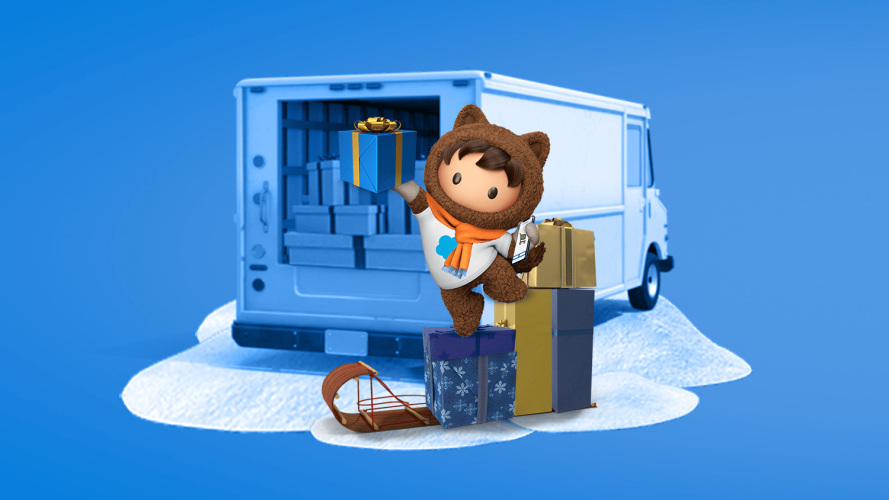What’s top of mind for every retailer going into the 2020 holiday shopping season? Last-mile fulfillment.
In the wake of COVID-19, retailers face continued strain on logistics. Even after widespread restrictions were lifted, retailers saw “holiday-like” numbers as consumers chose to buy both essential and non-essential goods online. In Q2 2020 alone, global digital revenue surged to 71% year-over-year.
What happens when you add the busiest shopping season of the year to an already strained fulfillment process? In a recent holiday predictions post, we projected capacity would exceed 5% globally between the week before Cyber Week through Boxing Day for traditional shippers. That’s 700 million gifts at risk.
Salesforce recently launched our annual holiday retail strategy and planning guide to help retailers navigate the upcoming shopping season. Let’s look at what you can do to prepare your fulfillment channels and find alternative solutions to save every gift.
1. Extend the season
According to a recent Salesforce consumer survey, 47% of shoppers are more interested in holiday shopping online than last year. The key is to avoid a crush during the five weeks between Thanksgiving Week and Christmas Day. The earlier your holiday shopping season starts, the fewer roadblocks to fulfillment.
With Prime Day shifting from July to October this year, retailers have an opportunity to start the season early and alleviate some of the burdens on fulfillment. Capitalize on Prime Day buzz with your promotions, whether it’s a special, one-time deal or a coveted product bundle. We recommend keeping these promotions exclusively available on your ecommerce site versus on a third-party marketplace. This way, you can maintain control of the entire process. (Another tip: Be selective about offering discounts. Great brands can easily get pigeonholed and lose customer loyalty because they play too much with pricing.)
Don’t be afraid to try out pre-orders either, particularly for limited-edition products. This creates a sense of urgency for your most sought-after products. Customers are comforted when they receive that must-have gift ahead of time, and retailers more accurately forecast production based on pre-order demand.
2. Expand pickup capabilities
Store pickup has been a lifeline for retailers. Customers receive products on their terms while retailers offset COVID-19 surcharges from delivery providers, projected to hit approximately $4.5 billion.
To quickly set up low and no-contact pickup options at your stores, try Quick Start for Curbside and Store Pickup solutions. The out-of-the-box capabilities have enabled brands to offer store inventory online while giving associates the tools they need to streamline fulfillment.
Don’t forget to encourage the splurge in the absence of in-store browsing. When a shopper gets a text or email that their order is ready for pickup, use AI-powered product recommendations (such as matching socks to go with new sneakers). Consider adding a coupon incentive. Or even place a digital screen at pickup points to showcase available merchandise.
3. Reskill holiday helpers
The idea of having an extra set of hands this holiday season is about to reach a whole new level. Associates can double as deliverers based on store radius — Michaels did this back in the height of the pandemic — or create/establish fulfillment-only roles at your “dark stores” designated for picking, sorting, and packing. To reskill associates on new processes, use digital learning tools like Salesforce’s customizable online learning platform, myTrailhead. Be sure to offer additional incentives, such as enhanced store discounts, to encourage them to learn new processes.
4. Partner with local providers
While Uber may have thanked people for not riding with them during the peak of the pandemic, retailers appreciated how ride-sharing services helped deliver essential products when traditional parcel delivery partners experienced unprecedented demand. As we enter the holiday season, consider forward-buys with crowdsourced transportation and delivery services to shore up capacity.
To make this work, you need complete inventory visibility. This way, you can move products from distribution centers to a local store so a driver can pick up and deliver within their particular geography.
5. Sweat the small stuff
This holiday season, every detail matters. Over-communicate with shoppers.
- Be clear about backorders and shipping delays. Feature updates prominently on your website. Direct shoppers to your help center for more information on operational delays or updates.
- Make inventory visible on your website. Shoppers may be apprehensive about purchasing an item that’s not available nearby because of the risk of delayed delivery. Lowe’s and Home Depot go so far as to show the number of units available in a local store.
- Nurture first-time digital shoppers. Put shoppers on a simple/straightforward digital journey. Provide regular updates on orders and access to service channels in the event of an issue.
Get started: Go the extra mile
There’s no doubt this will be a historic holiday shopping season. Go the extra mile to free up capacity and chart new ways to get shoppers the products they want.
For more best practices and input from leading industry experts as you prepare your digital and physical channels, read our comprehensive 2020 retail strategy and planning guide.




























